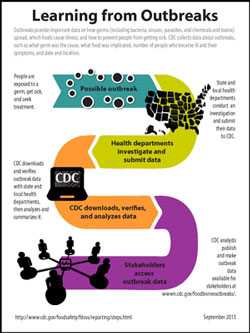Surveillance and Reporting
Did You Know?
98% of reported foodborne disease outbreaks involved only one state. Learn more …
CDC has a long history of summarizing outbreak reports from local and state health departments.
State and local public health authorities investigate all foodborne disease outbreaks. CDC coordinates those that involve multiple states; such outbreaks usually result from contaminated food that is widely distributed to many states. Data reported to CDC for each outbreak include the number of illnesses, hospitalizations, and deaths; the pathogens, toxins, and chemical agents that caused illnesses; the implicated food; the settings of food preparation and consumption; and factors contributing to food contamination.1
Foodborne disease outbreak surveillance and reporting provides valuable insights into the agents and foods that cause illness and the settings where contamination occurs.2
Knowing more about the foods, germs, and settings where outbreaks occur increases our understanding of its impact on human health and is the first step towards prevention.
Visit the CDC Foodborne Outbreak Tracking and Reporting website and learn more about:
- How tracking outbreaks identifies associated foods, pathogens, and settings
- CDC’s online systems for reporting and accessing foodborne outbreak data
- Data, Statistics, & Publications about foods, pathogens, and settings linked to foodborne outbreaks
- Fast facts about foodborne outbreaks
- CDC. Tracking and Reporting Foodborne Disease Outbreaks
- Gould LH, Walsh K, Vieira A, Herman K, Williams I, Hall A, Cole D. Surveillance for Foodborne Disease Outbreaks – United States, 1998-2008. Morb Mortal Wkly. Volume 62, Number SS2—June 2013
- Page last reviewed: October 14, 2016
- Page last updated: March 24, 2015
- Content source:


 ShareCompartir
ShareCompartir
